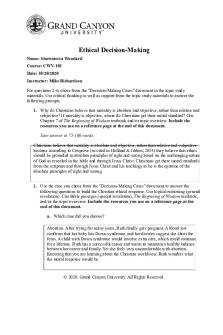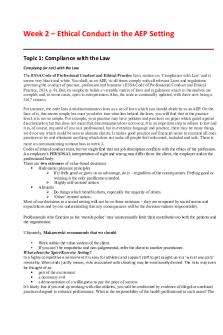Week 2 – Ethical Conduct in the AEP Setting PDF

| Title | Week 2 – Ethical Conduct in the AEP Setting |
|---|---|
| Course | Supporting Clients in Clinical Exercise |
| Institution | Charles Sturt University |
| Pages | 4 |
| File Size | 147.2 KB |
| File Type | |
| Total Downloads | 99 |
| Total Views | 124 |
Summary
Download Week 2 – Ethical Conduct in the AEP Setting PDF
Description
Week 2 – Ethical Conduct in the AEP Setting Topic 1: Compliance with the Law Complying (or not) with the Law The ESSA Code of Professional Conduct and Ethical Practice has a section on ‘Compliance with Law’ and it seems very black and white. You shall, as an AEP, ‘at all times comply with all relevant Laws and regulations governing the conduct of practice, profession and business’ (ESSA Code of Professional Conduct and Ethical Practice, 2014, p. 9). But, its simplicity belies a veritable matrix of laws and regulations which in themselves are complex and, in some cases, open to interpretation. Also, the code is continually updated, with there now being a 2017 version. For instance, the code lists Anti-discrimination laws as a set of laws which you should abide by as an AEP. On the face of it, this seems simple but once you delve into what lies behind the laws, you will find that at the practice level, it is not so simple. For example, your practice may have policies and practices on paper which guard against discrimination but this does not mean that discrimination does not occur. It is an important step to adhere to law and it is, of course, required of you as a professional, but in everyday language and practice, there may be many things we do or say which could be seen to alienate clients. It makes good practice and financial sense to examine all ones practices to try and eliminate anything which does not make all people feel welcomed, included and safe. There is more on communicating without bias in week 3. Codes of ethical conduct exist, but we might find that our job description conflicts with the ethics of the profession. An employee’s PERSONAL interpretation of right and wrong may differ from: the client, the employer and/or the professional body. There are two extremes of value-based decisions Hedonistic (pleasure principle) If it feels good or gives us an advantage, do it – regardless of the consequences. Feeling good or winning is the only justification needed. Highly self-centred notion Altruistic Do things which benefit others, especially the majority of others. ‘Other’ centred notion. Most of our decisions in a social setting will not be on these extremes – they are tempered by social norms and expectations and by our understanding that any consequences will be the decision-makers responsibility. Professionals who function as the ‘morals police’ may unnecessarily limit their contribution to both the patients and the organisation. Ultimately, Makarowski recommends that we should: Work within the value system of the client. If you can’t be empathetic and non-judgemental, refer the client to another practitioner. What about the Sport/Exercise Setting? In a highly competitive environment it is easy for athletes and support staff to get caught up in a ‘win at any costs’ mentality. When ends justify means, risks associated with cheating may be emotionally denied. The risks may even be thought of as: part of the excitement a necessary evil a demonstration of a willingness to pay the price of success It’s likely that if you end up working with elite athletes, you will be confronted by evidence of illegal or unethical practices deigned to enhance performance. What is the responsibility of the health professional in such cases? The
ESSA Code of Professional Conduct and Ethical Practice lists Laws pertaining to the use of illegal substances and drugs in sport as some of the laws AEP’s must comply with. However, the reality may not be so clear cut. While you might not be involved in prescribing performance enhancing drugs, you certainly might come across an athlete who admits being on such substances. Your role there may be complicated, especially if employed by the club (a club who knowingly gives its athletes such substances) or are friendly with the athlete themselves.
Topic 2: Privacy, Confidentiality and Consent As a health care provider, maintaining the privacy of your clients, adhering to regulations around confidentiality and ensuring you obtain consent when necessary from your clients, is paramount to good practice. Consent for Treatment Medical and dental treatment requires valid consent from the patient. If a patient lacks capacity, consent should be sought from their person responsible, except in situations where the treatment is urgent and necessary to save a person’s life or prevent serious damage to their health. This fact sheet summarises what patients, carers and health service providers need to know about valid informed consent. What is Informed Consent? Patients have a right to information about their health care and to make informed decisions about the treatment they
receive. Health care providers need to obtain valid consent before examining or treating a patient. For consent to be valid, the provider needs to ensure that the patient has:
the capacity to provide consent a good understanding of the general effect, material risks, benefits and alternatives of the proposed procedure or treatment. been informed about fees and charges before starting treatment. given their consent voluntarily and without any pressure to do so.
A patient can also refuse consent to treatment they do not want. Health care providers should give patients enough information about the proposed treatment to enable them to make an informed decision. Providers should encourage patients to ask questions to clarify anything they do not fully understand. This dialogue can assist providers to understand a patient’s comprehension of the information and whether they have capacity to provide informed consent. The health provider should not assume what the patient knows or understands. Please note: While the provider needs to ensure the patient has all the relevant information, it is the responsibility of the patient to weigh the information and make an informed decision. If it can be established that a provider has not provided the relevant information required for the consent to be considered valid, they could be charged with assault or risk legal liability for a complication or adverse outcome, even if it was not caused negligently.
What should be discussed with the patient?
2
Common side effects and risks Whether the procedure is conventional or experimental Who will undertake the intervention Other options for diagnosis and treatment The degree of uncertainty of the diagnosis and any therapeutic outcome The likely outcome of not having the diagnostic procedure or treatment or of not having any procedure or treatment at all Any significant long term physical, emotional, mental, social, sexual or other outcome which may be associated with the proposed intervention
The time and cost involved including any out of pocket expenses.
Capacity to Consent A person must have the capacity to understand and communicate what they are agreeing to for their consent to be valid. Some people, whether permanent or temporary, may lack capacity to consent. Where this is the case, a substitute decision maker can give consent on their behalf. Substitute decision makers A substitute decision maker can make a decision about treatment on behalf of a person who lacks capacity, in the person’s best interests. The substitute decision maker must consider all of the relevant information and must have the legal authority to act in this role. Exceptions Substitute consent is not required for:
urgent treatment needed to save a person’s life to prevent serious damage to their health for minor treatment that is necessary and in the person’s best interests and which the person who lacks capacity does not object to if there is no person responsible or they cannot be contacted. treatment or testing provided under certain legislation or required by a Court.
Informed consent for children Children under 14 years of age are considered to lack capacity to consent to their own treatment. Consent for treatment must be obtained from a child’s parent or legal guardian until the child turns 14. Consent can be obtained from one or both parents (regardless of marriage status), unless a Court Order has been made that gives one parent the sole responsibility. For children in care, the person or agency with ‘parental responsibility’ can consent. Informed consent for young people From the age of 14, a minor may be mature enough to give their own consent. Health practitioners should assess whether the young person is capable of consenting and if not, should seek the consent of their parent or guardian. A young person’s valid consent cannot be overruled by their parents. From 16 years of age, the consent of a young person is generally viewed as sufficient. Informed consent for adults who lack capacity Where a person is temporarily or permanently incapable of giving consent, a person responsible can consent to or refuse medical treatment on behalf of the person. Health providers should determine who the person responsible is and obtain informed consent from them prior to treating the patient. This could be a legally appointed guardian, or their spouse, unpaid carer, family member or friend who has a close and continuing relationship with the person. The NSW Guardianship Tribunal can provide...
Similar Free PDFs

APA ethical code of conduct
- 6 Pages

Ethical issues in the Mahabharata
- 19 Pages

Goal Setting in Counselling
- 20 Pages

Week 6 Ethical Decision Making 2
- 4 Pages

Setting the Restaurant
- 5 Pages

The Goal Setting Theory
- 4 Pages

Chapter 1: Setting the Scene
- 3 Pages

Ethical Issues IN Advertising
- 11 Pages

Ethical issues in engineering
- 226 Pages

AEP 4320 Assignment 5
- 2 Pages
Popular Institutions
- Tinajero National High School - Annex
- Politeknik Caltex Riau
- Yokohama City University
- SGT University
- University of Al-Qadisiyah
- Divine Word College of Vigan
- Techniek College Rotterdam
- Universidade de Santiago
- Universiti Teknologi MARA Cawangan Johor Kampus Pasir Gudang
- Poltekkes Kemenkes Yogyakarta
- Baguio City National High School
- Colegio san marcos
- preparatoria uno
- Centro de Bachillerato Tecnológico Industrial y de Servicios No. 107
- Dalian Maritime University
- Quang Trung Secondary School
- Colegio Tecnológico en Informática
- Corporación Regional de Educación Superior
- Grupo CEDVA
- Dar Al Uloom University
- Centro de Estudios Preuniversitarios de la Universidad Nacional de Ingeniería
- 上智大学
- Aakash International School, Nuna Majara
- San Felipe Neri Catholic School
- Kang Chiao International School - New Taipei City
- Misamis Occidental National High School
- Institución Educativa Escuela Normal Juan Ladrilleros
- Kolehiyo ng Pantukan
- Batanes State College
- Instituto Continental
- Sekolah Menengah Kejuruan Kesehatan Kaltara (Tarakan)
- Colegio de La Inmaculada Concepcion - Cebu





